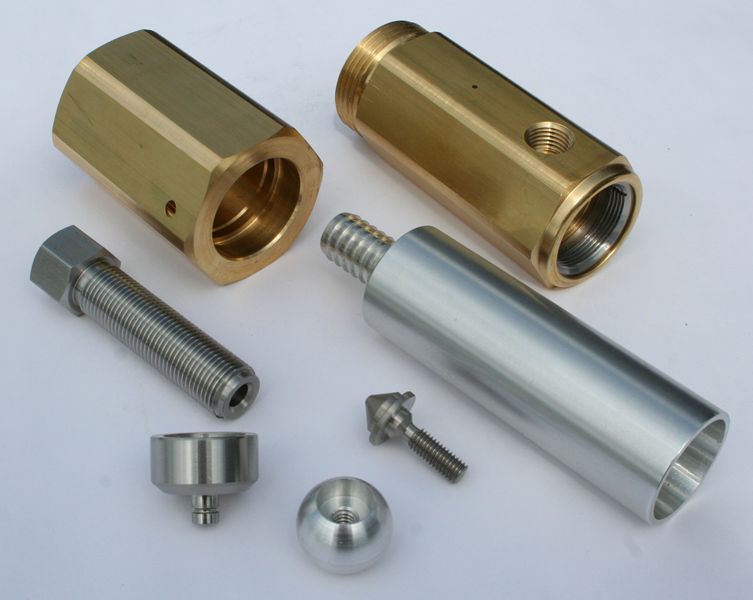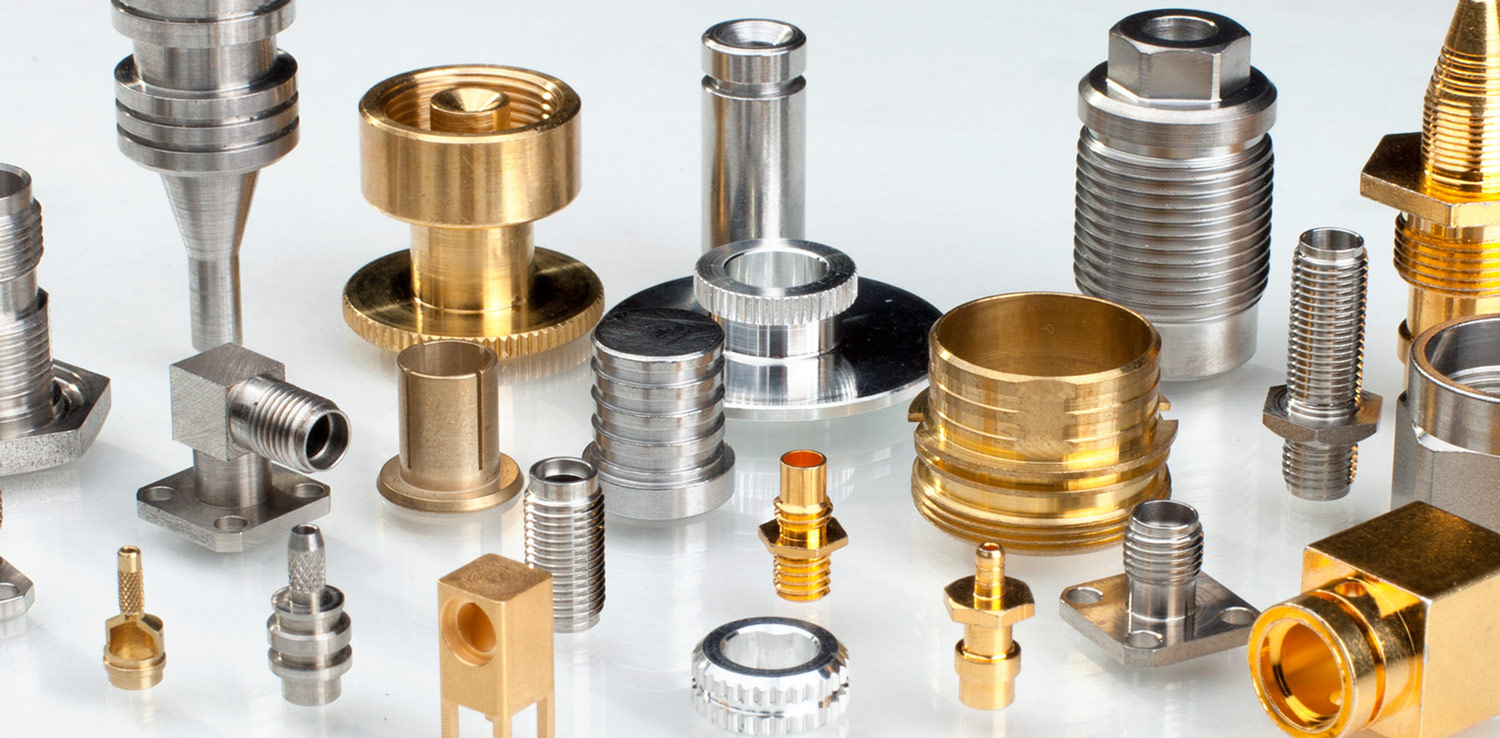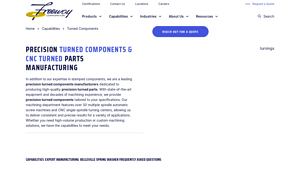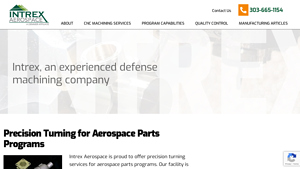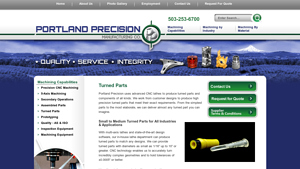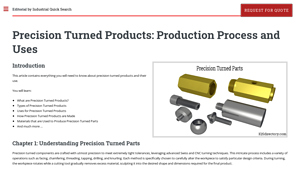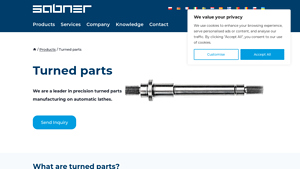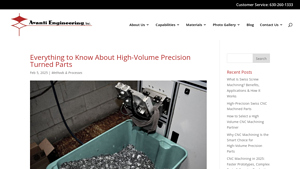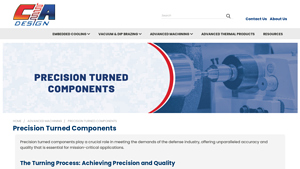Precision Turned Parts Guide: Type, Cost, Top List…
Introduction: Navigating the Global Market for precision turned parts
In today’s competitive landscape, sourcing precision turned parts can be a daunting challenge for international B2B buyers. As industries increasingly demand high-quality components that meet stringent specifications, navigating the complex global market requires a strategic approach. This guide is designed to empower decision-makers from regions such as Africa, South America, the Middle East, and Europe—especially Germany and Brazil—by providing a comprehensive overview of precision turned parts. From understanding the different types and applications of these components to essential supplier vetting processes, this resource aims to streamline your purchasing journey.
Throughout this guide, you will discover valuable insights into the manufacturing capabilities of precision turned parts, including the latest technologies and materials that enhance performance and durability. We will delve into critical factors such as cost considerations, quality standards, and the importance of certifications like ISO 9001:2015 and AS9100:2016, which are crucial for ensuring reliable suppliers. By equipping you with the knowledge needed to assess potential partners and make informed decisions, this guide serves as a vital tool for optimizing your supply chain and achieving operational excellence. Whether you’re in aerospace, automotive, or medical industries, understanding the intricacies of precision turned components will enable you to meet your production needs with confidence and precision.
Understanding precision turned parts Types and Variations
| Type Name | Key Distinguishing Features | Primary B2B Applications | Brief Pros & Cons for Buyers |
|---|---|---|---|
| Connector Bodies | High precision, complex geometries, and tight tolerances | Aerospace, Defense, Telecommunications | Pros: Excellent reliability and performance. Cons: Higher cost due to complexity. |
| Fittings | Variety of materials, custom designs, and precise thread integrity | Fluid Control, Medical Devices | Pros: Customizable for specific needs. Cons: Lead times may vary based on specifications. |
| Hardware Components | Robust construction, often made from brass or stainless steel | Automotive, Construction, HVAC | Pros: Durable and versatile. Cons: May require additional finishing processes. |
| Custom Machined Parts | Tailored designs, various secondary operations available | Heavy Machinery, Agriculture | Pros: Highly adaptable to unique applications. Cons: Complexity can increase production time. |
| Precision Washers | Consistent thickness, various diameters, and surface finishes | Electronics, Automotive, Industrial | Pros: Essential for assembly, ensuring tight fits. Cons: Limited to specific applications. |
What Are Connector Bodies and Their Key Features?
Connector bodies are essential precision turned parts known for their intricate designs and high precision. Typically utilized in aerospace and telecommunications, they require tight tolerances and superior thread integrity to ensure reliable connections. When purchasing, buyers should consider the material options, as they can significantly affect performance in demanding environments. The complexity of these parts may lead to higher costs, but their reliability justifies the investment.
How Do Fittings Serve Various Industries?
Fittings are precision turned components that play a crucial role in fluid control and medical applications. They come in various materials and can be custom-designed to meet specific requirements. B2B buyers should assess the compatibility of fittings with their existing systems and the potential need for unique designs. While they offer great customization options, lead times can be longer depending on the complexity of the specifications.
What Characteristics Define Hardware Components?
Hardware components are robust and versatile precision turned parts often crafted from durable materials like brass and stainless steel. They find applications in automotive, construction, and HVAC industries. Buyers should evaluate the part’s durability and potential for additional finishing processes that may enhance performance. While they are generally reliable, the need for secondary operations can increase overall costs and production time.
How Do Custom Machined Parts Fit into the Market?
Custom machined parts are tailored solutions that cater to unique application requirements across industries such as heavy machinery and agriculture. These parts can undergo various secondary operations, making them highly adaptable. B2B buyers should consider the specific needs of their applications and the potential complexities involved in production. The adaptability of custom parts can come at a cost, potentially increasing lead times.
Why Are Precision Washers Important in Assembly?
Precision washers are vital components that ensure proper spacing and fit in various assemblies, particularly in electronics and automotive applications. They are manufactured to consistent thickness and come in multiple diameters, with specific surface finishes enhancing their performance. Buyers should focus on the specifications required for their applications to ensure compatibility. While essential for assembly, their applications are somewhat limited, which could restrict their utility in broader contexts.
Key Industrial Applications of precision turned parts
| Industry/Sector | Specific Application of Precision Turned Parts | Value/Benefit for the Business | Key Sourcing Considerations for this Application |
|---|---|---|---|
| Aerospace | Components for aircraft engines and landing gear | Ensures safety and reliability in critical aerospace systems | Compliance with stringent aerospace standards and certifications |
| Medical | Surgical instruments and implants | High precision leads to better patient outcomes and safety | Material biocompatibility and regulatory compliance |
| Automotive | Engine components, fittings, and fasteners | Enhances vehicle performance and longevity | High-volume production capabilities and tight tolerances |
| Telecommunications | Connectors and fittings for communication devices | Reliable performance ensures uninterrupted services | Ability to meet specific material and design requirements |
| Fluid Control Systems | Valves and fittings for hydraulic and pneumatic systems | Increases efficiency and reduces maintenance costs | Expertise in handling diverse materials and complex geometries |
How Are Precision Turned Parts Utilized in Aerospace Applications?
In the aerospace industry, precision turned parts are critical for manufacturing components like engine parts and landing gear assemblies. These components must adhere to stringent safety standards and tolerances due to their role in flight safety. International buyers, especially from Europe and the Middle East, need to ensure that their suppliers are certified to aerospace standards such as AS9100. The ability to provide traceability and quality assurance documentation is essential for maintaining compliance.
What Role Do Precision Turned Parts Play in Medical Applications?
In the medical sector, precision turned parts are used to manufacture surgical instruments, implants, and diagnostic devices. The high precision of these components is vital for patient safety and effective treatment outcomes. Buyers must consider sourcing from manufacturers who can provide biocompatible materials and comply with health regulations like ISO 13485. This is particularly important for international B2B buyers who may face varying regulatory landscapes.
How Are Precision Turned Parts Beneficial for Automotive Manufacturing?
Precision turned components are integral to the automotive industry, used in engine assemblies, transmission systems, and various fittings. These parts enhance vehicle performance and reliability, which are critical in a highly competitive market. For businesses in South America and Africa, sourcing partners must demonstrate high-volume production capabilities and the ability to maintain tight tolerances to meet automotive industry standards.
Why Are Precision Turned Parts Essential for Telecommunications?
In telecommunications, precision turned parts such as connectors and fittings are vital for ensuring the reliability of communication systems. These components facilitate seamless data transmission, which is crucial in today’s digital age. When sourcing from international suppliers, buyers should prioritize manufacturers who can meet specific material requirements and offer customization options to suit unique application needs.
How Do Precision Turned Parts Contribute to Fluid Control Systems?
Precision turned parts are extensively used in fluid control systems, including valves and fittings for hydraulic and pneumatic applications. These components enhance system efficiency and minimize maintenance needs. Buyers from various regions should look for suppliers with expertise in machining complex geometries and a proven track record in handling a variety of materials, ensuring that the components meet operational demands.
3 Common User Pain Points for ‘precision turned parts’ & Their Solutions
Scenario 1: Inconsistent Quality Leading to Production Delays
The Problem: Many B2B buyers face the challenge of inconsistent quality in precision turned parts, which can lead to significant production delays. This inconsistency often arises from inadequate quality control measures by manufacturers or a lack of understanding of specific material properties required for their applications. For instance, a company manufacturing automotive components may receive turned parts with tight tolerances that do not meet their specifications, causing a halt in production lines and delaying product launches.
The Solution: To mitigate this issue, buyers should prioritize sourcing from manufacturers who adhere to international quality standards such as ISO 9001:2015 and AS9100:2016. It is crucial to conduct a thorough vetting process, which includes requesting quality certifications, reviewing past performance metrics, and, if feasible, visiting manufacturing facilities. Buyers should also establish clear quality specifications upfront, including detailed drawings and tolerances, and maintain open communication channels with suppliers throughout the production process. This proactive approach not only enhances product quality but also fosters a collaborative relationship that can lead to long-term partnerships.
Scenario 2: Difficulty in Sourcing Custom Precision Turned Parts
The Problem: Sourcing custom precision turned parts can be a daunting task for B2B buyers, particularly when dealing with unique specifications or materials that are not readily available. This is especially true for industries like aerospace or medical, where components often require specialized materials and intricate designs. Buyers may struggle to find suppliers who can meet their specific needs within a reasonable timeframe, leading to potential project delays and increased costs.
The Solution: To effectively source custom precision turned parts, buyers should engage with manufacturers that specialize in custom solutions and have a robust engineering support team. It’s advisable to provide comprehensive design documentation and engage in collaborative discussions with potential suppliers during the early stages of product development. Additionally, leveraging advanced technologies such as CAD (Computer-Aided Design) can facilitate clearer communication of design specifications and help manufacturers better understand the complexities of the requested parts. Building strong relationships with suppliers who are willing to invest time in understanding the unique challenges of your project can significantly streamline the sourcing process and lead to innovative solutions that meet your specifications.
Scenario 3: Supply Chain Disruptions Affecting Timely Deliveries
The Problem: International buyers often encounter supply chain disruptions that can severely impact the timely delivery of precision turned parts. Factors such as geopolitical tensions, natural disasters, and fluctuating transportation costs can lead to unpredictable delays. For companies in sectors like automotive or healthcare, where timely delivery is critical, these disruptions can translate into lost revenue and damaged reputations.
The Solution: To navigate potential supply chain challenges, buyers should consider diversifying their supplier base and working with manufacturers who offer flexible stocking solutions and just-in-time (JIT) delivery options. Establishing agreements with multiple suppliers can provide a buffer against disruptions, allowing buyers to shift orders as needed. Furthermore, investing in technologies that provide real-time tracking and inventory management can enhance visibility across the supply chain. By leveraging data analytics, businesses can anticipate potential disruptions and make informed decisions about inventory levels and sourcing strategies, thereby minimizing the impact on production schedules and ensuring a steady supply of precision turned parts.
Strategic Material Selection Guide for precision turned parts
What Are the Key Properties of Common Materials Used in Precision Turned Parts?
When selecting materials for precision turned parts, it is essential to consider their properties in relation to the intended application. Here, we analyze four common materials: stainless steel, brass, aluminum, and carbon steel, focusing on their performance characteristics, advantages, disadvantages, and implications for international buyers.
How Does Stainless Steel Perform in Precision Turned Applications?
Stainless steel is renowned for its excellent corrosion resistance, durability, and strength, making it suitable for high-pressure and high-temperature applications. Key grades like 304 and 316 offer specific benefits, with 316 providing superior resistance to chlorides. However, stainless steel can be more challenging to machine due to its toughness, which may increase manufacturing complexity and costs.
Pros: High durability, excellent corrosion resistance, and suitability for harsh environments.
Cons: Higher manufacturing costs and potential difficulty in machining.
Impact on Application: Ideal for medical, aerospace, and marine applications where hygiene and corrosion resistance are critical.
Considerations for International Buyers: Compliance with ASTM standards is crucial, particularly for industries in Europe and North America. Buyers should also be aware of the varying grades and their specific properties.
What Are the Advantages of Using Brass in Precision Turned Parts?
Brass is a popular choice for precision turned components due to its excellent machinability and good corrosion resistance. It is often used in applications requiring electrical conductivity and low friction, such as fittings and connectors. However, brass may not perform well in high-stress or high-temperature environments.
Pros: Easy to machine, good corrosion resistance, and suitable for electrical applications.
Cons: Limited high-temperature performance and can be more expensive than aluminum.
Impact on Application: Commonly used in plumbing, electrical, and decorative applications.
Considerations for International Buyers: Compliance with JIS standards is important in Asia, while European buyers may prefer materials meeting DIN standards.
Why Choose Aluminum for Precision Turned Components?
Aluminum is lightweight, corrosion-resistant, and offers excellent thermal and electrical conductivity. Its low density makes it ideal for applications where weight savings are critical, such as in automotive and aerospace industries. However, aluminum is softer than other materials, which may lead to wear in high-friction applications.
Pros: Lightweight, good corrosion resistance, and excellent machinability.
Cons: Lower strength compared to steel and may wear faster in high-friction environments.
Impact on Application: Suitable for automotive, aerospace, and consumer electronics applications.
Considerations for International Buyers: Buyers should ensure compliance with international standards such as ASTM and ISO, particularly for aerospace applications.
What Role Does Carbon Steel Play in Precision Turned Parts?
Carbon steel is known for its high strength and hardness, making it suitable for heavy-duty applications. It can be heat-treated to enhance its properties, but it is less corrosion-resistant than stainless steel or brass. This material is often used in applications where strength is prioritized over corrosion resistance.
Pros: High strength, good wear resistance, and cost-effective.
Cons: Poor corrosion resistance and may require protective coatings.
Impact on Application: Commonly used in automotive, construction, and industrial machinery.
Considerations for International Buyers: Compliance with ASTM standards is essential, especially for buyers in North America and Europe.
Summary Table of Material Selection for Precision Turned Parts
| Material | Typical Use Case for Precision Turned Parts | Key Advantage | Key Disadvantage/Limitation | Relative Cost (Low/Med/High) |
|---|---|---|---|---|
| Stainless Steel | Aerospace, medical devices | Excellent corrosion resistance | Higher manufacturing complexity | High |
| Brass | Plumbing fittings, electrical connectors | Good machinability | Limited high-temperature performance | Medium |
| Aluminum | Automotive, consumer electronics | Lightweight and corrosion-resistant | Softer, may wear in high-friction | Medium |
| Carbon Steel | Industrial machinery, automotive components | High strength and cost-effective | Poor corrosion resistance | Low |
This strategic material selection guide provides essential insights for international B2B buyers in Africa, South America, the Middle East, and Europe, helping them make informed decisions based on the specific requirements of their applications.
In-depth Look: Manufacturing Processes and Quality Assurance for precision turned parts
What Are the Main Stages of Manufacturing Precision Turned Parts?
The manufacturing of precision turned parts involves several key stages, each crucial to ensuring the final product meets stringent specifications. These stages typically include material preparation, forming, assembly, and finishing.
-
Material Preparation: The process begins with selecting high-quality raw materials, such as stainless steel, brass, aluminum, and copper. Materials are often sourced based on specific application requirements, including strength, corrosion resistance, and thermal properties. Once the materials are selected, they are cut into appropriate lengths and diameters, ensuring they meet the necessary specifications before moving to the next stage.
-
Forming: In this stage, the actual shaping of the parts occurs. This is primarily achieved through CNC turning, where a rotating workpiece is shaped by a cutting tool. Manufacturers may utilize various turning centers, including multi-spindle and CNC machines, to achieve tight tolerances and complex geometries. Techniques such as broaching, milling, and drilling may also be employed to achieve desired features like slots, holes, and threads.
-
Assembly: While many precision turned parts are produced as standalone components, some require assembly with other parts. This may involve additional processes such as threading or spline rolling to ensure parts fit seamlessly together. Quality during assembly is critical, as any misalignment can compromise the function and reliability of the final product.
-
Finishing: The finishing stage focuses on enhancing the part’s surface quality and overall performance. Techniques like deburring, burnishing, and cleaning are employed to remove any sharp edges, improve surface finish, and ensure cleanliness. Depending on the application, additional processes like plating or heat treatment may be applied to enhance properties such as wear resistance and corrosion protection.
How Do Quality Assurance Processes Ensure Precision in Manufacturing?
Quality assurance (QA) is integral to the production of precision turned parts, ensuring that each component meets both international and industry-specific standards. The following outlines the critical aspects of QA processes:
-
International Standards Compliance: Most reputable manufacturers adhere to international standards such as ISO 9001:2015 and AS9100:2016. These certifications indicate a commitment to quality management systems and continuous improvement. Buyers from regions like Africa, South America, the Middle East, and Europe can verify these certifications to ensure that suppliers maintain high-quality standards.
-
Industry-Specific Certifications: Depending on the application, additional certifications may be required. For instance, parts used in the aerospace sector must comply with stringent standards set by regulatory bodies, while medical components may need CE marking to indicate conformity with health and safety regulations. Understanding these certifications is vital for B2B buyers, as they can significantly impact the product’s acceptance in specific markets.
-
Quality Control Checkpoints: Effective quality control involves multiple checkpoints throughout the manufacturing process:
– Incoming Quality Control (IQC): This involves inspecting raw materials upon arrival to ensure they meet specified criteria.
– In-Process Quality Control (IPQC): Regular inspections during production ensure adherence to design specifications and tolerances.
– Final Quality Control (FQC): At the end of the manufacturing process, components undergo final inspections to confirm they meet all quality standards before shipment. -
Testing Methods: Common testing methods for precision turned parts include dimensional inspections, hardness testing, surface finish assessments, and non-destructive testing (NDT). These methods help identify any defects or deviations from specifications, ensuring only high-quality parts are delivered to clients.
How Can B2B Buyers Verify Supplier Quality Control?
B2B buyers must implement strategies to assess and verify the quality control practices of potential suppliers. Here are several actionable steps:
-
Conduct Audits: Regular audits of supplier facilities can provide insights into their manufacturing processes, quality control measures, and adherence to international standards. Buyers should consider scheduling both announced and unannounced audits to obtain an accurate view of operations.
-
Request Quality Reports: Suppliers should be willing to provide documentation regarding their quality control processes, including inspection reports, testing results, and certifications. Reviewing these documents can help buyers gauge the supplier’s commitment to quality.
-
Engage Third-Party Inspectors: Utilizing independent third-party inspection services can add an extra layer of assurance. These organizations can conduct quality assessments and provide unbiased reports on the quality of the components supplied.
-
Understand Regional Nuances: International buyers should be aware of specific regional standards and regulations that may affect quality control. For example, suppliers in Europe may have different compliance requirements than those in Africa or South America. Ensuring alignment with these regional standards is essential for seamless market entry.
What Are the Common Challenges in Quality Assurance for International B2B Buyers?
When dealing with international suppliers, B2B buyers may face several challenges related to quality assurance:
-
Communication Barriers: Language differences can lead to misunderstandings regarding specifications, quality expectations, and timelines. Establishing clear communication channels and using standardized documentation can mitigate these issues.
-
Cultural Differences: Variations in business practices and cultural norms may affect how quality is perceived and prioritized. Buyers should be culturally aware and adaptable when working with suppliers from different regions.
-
Supply Chain Complexity: The global supply chain introduces complexities such as varying lead times, shipping regulations, and customs processes. Understanding these factors can help buyers better plan for quality assurance and ensure timely delivery of components.
-
Regulatory Compliance: Different regions have distinct regulatory requirements that can affect quality standards. Buyers should familiarize themselves with these regulations to ensure that their suppliers can meet necessary compliance standards.
By understanding the manufacturing processes and quality assurance measures involved in precision turned parts, B2B buyers can make informed decisions and develop strong partnerships with reliable suppliers, ultimately leading to enhanced operational efficiency and product quality.
Practical Sourcing Guide: A Step-by-Step Checklist for ‘precision turned parts’
Introduction
This sourcing guide aims to provide international B2B buyers with a practical checklist for procuring precision turned parts. These components play a crucial role across various industries, including automotive, aerospace, and medical. By following this step-by-step guide, buyers can ensure they select high-quality suppliers that meet their technical and operational needs.
Step 1: Define Your Technical Specifications
Clearly outline the technical requirements for your precision turned parts. This includes dimensions, tolerances, material types, and surface finishes. A well-defined specification ensures that suppliers understand your needs and can deliver components that meet stringent quality standards.
- Material Selection: Consider the application of the parts to choose appropriate materials such as stainless steel, brass, or aluminum.
- Tolerances: Specify the required tolerances to ensure parts fit seamlessly into their intended applications.
Step 2: Research Potential Suppliers
Conduct thorough research to identify potential suppliers that specialize in precision turned components. Look for companies with a strong reputation, extensive experience, and a portfolio that aligns with your needs.
- Online Reviews and Ratings: Check platforms like LinkedIn, industry forums, and Google reviews to gauge supplier reliability.
- Industry Certifications: Ensure suppliers have relevant certifications such as ISO 9001:2015 or AS9100:2016, indicating adherence to quality management standards.
Step 3: Evaluate Supplier Capabilities
Assess the manufacturing capabilities of shortlisted suppliers. This involves understanding their production processes, equipment, and the range of services they offer.
- Machining Technology: Inquire about the type of CNC machines and turning centers they utilize. Advanced technology often correlates with higher precision and efficiency.
- Production Volume Flexibility: Ensure the supplier can accommodate both low and high-volume production runs as your needs may vary.
Step 4: Verify Supplier Certifications
Before finalizing any agreements, verify the certifications claimed by the supplier. This step is critical to ensure compliance with industry standards and regulations.
- Request Documentation: Ask for copies of their certifications and quality assurance processes.
- Audit History: Inquire about their audit history and any corrective actions taken to maintain compliance.
Step 5: Request Samples and Prototypes
Engage potential suppliers by requesting samples or prototypes of the precision turned parts. This allows you to assess the quality, fit, and functionality before placing a larger order.
- Testing for Quality: Use the samples to conduct tests that reflect your application’s requirements, such as stress tests or fit checks.
- Feedback Loop: Provide detailed feedback to suppliers based on your assessment to ensure continuous improvement.
Step 6: Assess Pricing and Terms
Once you have identified a suitable supplier, evaluate their pricing structure and payment terms. Competitive pricing is essential, but it should not compromise quality.
- Cost Analysis: Compare quotes from multiple suppliers, considering not only the price but also the value of quality and service offered.
- Payment Flexibility: Discuss payment terms that work for both parties, such as installment payments for larger orders.
Step 7: Establish Clear Communication Channels
Finally, ensure that there are clear communication channels established with your chosen supplier. Effective communication is key to a successful partnership and can help mitigate potential issues.
- Regular Updates: Set expectations for regular updates on production status and delivery timelines.
- Point of Contact: Designate a point of contact on both sides to facilitate smooth communication and address any concerns promptly.
By following this checklist, B2B buyers can confidently navigate the sourcing process for precision turned parts, ensuring they partner with suppliers who meet their technical, quality, and operational requirements.
Comprehensive Cost and Pricing Analysis for precision turned parts Sourcing
What Are the Key Cost Components for Precision Turned Parts?
When sourcing precision turned parts, understanding the cost structure is crucial for effective budgeting and decision-making. The primary cost components include:
-
Materials: The choice of material significantly impacts the price. Common materials like stainless steel, brass, and aluminum vary in cost based on market demand and availability. Specialty materials may incur higher prices due to their unique properties or sourcing challenges.
-
Labor: Skilled labor is essential for manufacturing precision components. Labor costs can fluctuate based on the region, with higher wages in developed countries compared to emerging markets.
-
Manufacturing Overhead: This encompasses costs related to machinery maintenance, utilities, and facility operations. Efficient manufacturing processes can reduce overhead, impacting the overall cost of parts.
-
Tooling: Initial tooling costs can be substantial, particularly for custom parts. Investing in high-quality tooling is essential for achieving the desired precision and may require amortization over larger production runs.
-
Quality Control (QC): Ensuring that parts meet stringent quality standards is non-negotiable in precision manufacturing. QC processes, including inspections and certifications, add to the overall cost but are vital for maintaining product integrity.
-
Logistics: Shipping and handling costs can vary based on the supplier’s location and the buyer’s destination. Consideration of Incoterms is essential in determining who bears the logistics costs.
-
Margin: Suppliers typically add a profit margin to their costs, which can vary based on market competition and the perceived value of their services.
How Do Price Influencers Affect the Cost of Precision Turned Parts?
Several factors can influence the pricing of precision turned parts, including:
-
Volume and Minimum Order Quantity (MOQ): Larger orders often benefit from economies of scale, resulting in lower per-unit costs. Conversely, small orders may incur higher prices due to fixed costs being spread over fewer units.
-
Specifications and Customization: Custom parts with unique specifications generally cost more than standard components. Detailed engineering requirements can also lead to increased labor and tooling costs.
-
Quality and Certifications: Parts requiring specific certifications (like ISO or AS9100) may be priced higher due to the additional quality assurance processes involved. Buyers should assess whether these certifications are necessary for their applications.
-
Supplier Factors: The reputation and experience of the supplier can impact pricing. Established suppliers may command higher prices due to their proven reliability and quality assurance.
-
Incoterms: Understanding the terms of shipping and delivery is crucial. Different Incoterms can shift responsibilities and costs between buyers and sellers, affecting total expenses.
What Are the Best Practices for Negotiating Costs in Precision Turned Parts Sourcing?
For international B2B buyers, particularly from regions such as Africa, South America, the Middle East, and Europe, several strategies can enhance cost-efficiency:
-
Negotiation: Engage suppliers in discussions about pricing, especially for larger orders. Suppliers may be willing to offer discounts or better terms for committed long-term partnerships.
-
Total Cost of Ownership (TCO): Evaluate the overall cost beyond the purchase price, including logistics, maintenance, and potential downtime. A lower initial price might not always yield the best long-term value.
-
Pricing Nuances for International Buyers: Be aware of currency fluctuations, import tariffs, and local taxes that can affect overall costs. Establishing a clear understanding of these factors is essential for accurate budgeting.
-
Supplier Relationships: Building strong relationships with suppliers can lead to better pricing and priority service. Open communication about needs and challenges fosters collaboration and may yield favorable terms.
Disclaimer for Indicative Prices
Prices for precision turned parts can vary widely based on the factors outlined above. It is advisable for buyers to obtain quotes from multiple suppliers and conduct thorough market research to ensure they are making informed purchasing decisions.
Alternatives Analysis: Comparing precision turned parts With Other Solutions
Exploring Alternatives to Precision Turned Parts in Manufacturing
When considering manufacturing solutions, precision turned parts are often a go-to option due to their high accuracy and reliability. However, various alternative methods and technologies may also meet specific needs in different contexts. Understanding these alternatives can help B2B buyers make informed decisions based on performance, cost, and application suitability.
| Comparison Aspect | Precision Turned Parts | CNC Machining | Injection Molding |
|---|---|---|---|
| Performance | High precision with tight tolerances | Excellent for complex geometries | Good for high-volume, uniform parts |
| Cost | Moderate to high, depending on volume | Generally higher due to setup | Low per unit at high volumes |
| Ease of Implementation | Requires skilled operators and setup | Complex setup, requires expertise | Relatively straightforward, once set up |
| Maintenance | Low, but depends on tooling and machines | Moderate, needs regular servicing | Low, minimal wear on molds |
| Best Use Case | Aerospace, automotive, medical applications | Complex parts, low-to-medium volume | High-volume production of uniform parts |
In-Depth Analysis of Alternatives
What Are the Advantages and Disadvantages of CNC Machining?
CNC machining is a versatile manufacturing method that offers high precision for complex geometries. While it can produce intricate designs that precision turned parts may struggle with, the initial setup costs and time can be significantly higher. This method is ideal for low- to medium-volume production runs where detail is paramount, such as in the aerospace and automotive industries. However, the requirement for skilled operators can limit its accessibility for some businesses.
How Does Injection Molding Compare to Precision Turned Parts?
Injection molding is a popular alternative for producing high volumes of uniform parts efficiently. The cost per unit decreases significantly as production scales, making it highly economical for mass production. However, it typically lacks the precision and tight tolerances that precision turned parts offer, which may be crucial in applications like medical devices or aerospace components. The initial mold costs can also be high, which makes it less ideal for low-volume projects.
Making the Right Choice: Which Solution Fits Your Needs?
When deciding between precision turned parts and their alternatives, B2B buyers should assess their specific project requirements, including production volume, part complexity, and tolerance levels. For applications that demand high precision and tight tolerances, precision turned parts are often the best choice. Conversely, for high-volume needs with less stringent tolerances, injection molding may offer significant cost savings. CNC machining serves as a middle ground for projects requiring detailed designs without the constraints of mass production. Ultimately, the right solution will depend on balancing performance, cost, and operational capabilities within your business context.
Essential Technical Properties and Trade Terminology for precision turned parts
What Are the Key Technical Properties of Precision Turned Parts?
Understanding the technical specifications of precision turned parts is essential for B2B buyers to ensure they make informed purchasing decisions. Here are some critical specifications that define the quality and applicability of these components:
1. Material Grade
Precision turned parts can be made from various materials, including stainless steel, carbon steel, brass, copper, and aluminum. The choice of material significantly influences the part’s strength, corrosion resistance, and suitability for specific applications. For example, stainless steel is preferred in medical and aerospace applications due to its durability and resistance to rust, while brass may be chosen for electrical components due to its excellent conductivity.
2. Tolerance
Tolerance refers to the allowable deviation from a specified dimension. In precision turned parts, tight tolerances (often within ±0.001 inches or less) are critical for ensuring that components fit together seamlessly in assemblies. This precision is vital for industries such as automotive and aerospace, where even minor deviations can lead to failure or inefficiencies. Understanding tolerance levels helps buyers ensure the parts will perform reliably in their intended applications.
3. Surface Finish
Surface finish, measured in micro-inches, indicates the smoothness of a component’s surface. A finer finish (e.g., 32 micro-inches) can enhance performance by reducing friction and wear, making it particularly important in high-speed or high-load applications. Buyers should consider the required surface finish based on the part’s functional requirements and the environment in which it will operate.
4. Quantity and Scalability
B2B buyers often need parts in various quantities, from small batches to millions of units. Understanding the manufacturer’s capabilities to scale production efficiently is crucial. This includes assessing their machinery (e.g., multi-spindle vs. CNC turning centers) and their ability to maintain quality across different production volumes. Knowing the Minimum Order Quantity (MOQ) helps buyers plan their procurement strategy effectively.
5. Secondary Operations
Secondary operations enhance the functionality and precision of turned parts. Common processes include broaching, threading, and deburring. Understanding what secondary operations are available allows buyers to consolidate their supply chain, ensuring that all necessary modifications are handled by a single manufacturer, thus reducing lead times and potential errors.
What Are Common Trade Terms in the Precision Turned Parts Industry?
Familiarity with industry jargon can facilitate smoother communication and negotiations. Here are some essential terms that B2B buyers should know:
1. OEM (Original Equipment Manufacturer)
An OEM refers to a company that produces parts or equipment that are marketed by another company. Understanding OEM relationships is crucial for buyers, as they may need to source components that meet specific standards set by their OEM partners, ensuring compatibility and quality.
2. MOQ (Minimum Order Quantity)
MOQ is the smallest quantity of a product that a supplier is willing to sell. Knowing the MOQ helps buyers manage their inventory and budget effectively, as it can influence purchasing decisions and production planning.
3. RFQ (Request for Quotation)
An RFQ is a formal document sent to suppliers requesting pricing and other relevant information for a specific quantity of parts. Submitting RFQs is a standard practice in B2B transactions, allowing buyers to compare offers and select the best supplier based on price, quality, and delivery terms.
4. Incoterms
Incoterms (International Commercial Terms) define the responsibilities of buyers and sellers in international transactions. Familiarity with these terms helps buyers understand shipping costs, risks, and delivery responsibilities, crucial for effective logistics planning, especially in regions like Africa and South America where supply chains may vary significantly.
5. Lead Time
Lead time refers to the time taken from placing an order to the delivery of the product. Knowing the expected lead times helps buyers plan their production schedules and manage inventory levels effectively, ensuring that they meet customer demands without overstocking.
By grasping these technical properties and trade terms, B2B buyers can navigate the complexities of sourcing precision turned parts, ensuring they select the best components for their specific needs.
Navigating Market Dynamics and Sourcing Trends in the precision turned parts Sector
What Are the Key Market Trends Impacting Precision Turned Parts?
The precision turned parts market is experiencing significant growth, driven by several global factors. The increasing demand for high-quality, precision-engineered components across diverse industries such as automotive, aerospace, and healthcare is a primary driver. In particular, the rise of electric vehicles and advanced manufacturing technologies has heightened the need for precision turned components that meet stringent quality standards. Emerging technologies, including Industry 4.0 and the Internet of Things (IoT), are transforming sourcing strategies, allowing manufacturers to enhance operational efficiency and reduce lead times.
International B2B buyers are increasingly seeking suppliers who offer not only competitive pricing but also advanced technical support and customization options. The trend toward just-in-time (JIT) manufacturing is compelling suppliers to adopt lean manufacturing practices, thereby improving delivery performance and responsiveness. Additionally, the integration of advanced machining processes, such as CNC turning and multi-spindle machining, has expanded the capabilities to produce intricate designs with tight tolerances, catering to the complex needs of global markets, particularly in Europe, Africa, and South America.
How Is Sustainability Shaping Sourcing Decisions in Precision Turned Parts?
Sustainability is becoming a critical consideration in the sourcing of precision turned parts. Environmental impacts associated with manufacturing processes, including waste generation and energy consumption, are prompting companies to adopt greener practices. B2B buyers are increasingly prioritizing suppliers who demonstrate a commitment to sustainability, such as utilizing recycled materials or implementing energy-efficient production techniques.
The importance of ethical supply chains cannot be overstated. Buyers are now more inclined to partner with manufacturers who are transparent about their sourcing practices and labor conditions. Certifications such as ISO 14001 for environmental management and adherence to ethical labor standards are becoming essential criteria for supplier selection. Moreover, the adoption of ‘green’ materials, such as bio-based plastics and low-emission metals, is gaining traction, aligning with global sustainability goals. This shift not only mitigates environmental impact but also enhances brand reputation in an increasingly eco-conscious marketplace.
How Has the Precision Turned Parts Sector Evolved Over Time?
The evolution of the precision turned parts sector has been marked by significant technological advancements and changing market demands. Initially, precision turning relied heavily on manual machining methods, which limited scalability and precision. The introduction of CNC technology revolutionized the industry by allowing for higher precision, repeatability, and the ability to handle complex geometries.
Over the past few decades, the global landscape has also shifted, with a move toward outsourcing and global supply chains. This transition has enabled manufacturers to tap into emerging markets and benefit from cost efficiencies. As industries continue to evolve, the precision turned parts sector is adapting by focusing on automation, advanced materials, and sustainability, ensuring that it remains a vital component of modern manufacturing. This ongoing evolution presents international B2B buyers with opportunities to leverage innovation for their own competitive advantage.
Frequently Asked Questions (FAQs) for B2B Buyers of precision turned parts
-
How do I solve challenges in sourcing precision turned parts from international suppliers?
To address sourcing challenges, begin by clearly defining your specifications, including material type, dimensions, and tolerances. Next, conduct thorough research on potential suppliers, focusing on their certifications (like ISO 9001), manufacturing capabilities, and industry reputation. Utilize platforms like Alibaba or ThomasNet to find verified suppliers. Establish direct communication to discuss your specific needs and inquire about their experience with similar projects. Additionally, consider requesting samples before placing a large order to ensure the quality meets your expectations. -
What is the best way to ensure quality when sourcing precision turned components?
The best approach to ensure quality is to partner with suppliers who have robust quality assurance processes in place. Look for manufacturers with ISO certifications and experience in your industry. Request detailed documentation, such as material certifications and inspection reports, to verify compliance with your specifications. Implement regular audits or inspections throughout the production process. Establish a clear communication channel for feedback and potential adjustments, ensuring that any quality concerns are addressed promptly. -
What are the minimum order quantities (MOQ) for precision turned parts?
Minimum order quantities can vary widely depending on the manufacturer and complexity of the parts. Typically, MOQs may range from 100 to several thousand pieces. When negotiating with suppliers, express your needs clearly; some manufacturers may accommodate smaller orders, especially for custom parts, while others may require larger quantities to justify setup costs. Always clarify MOQs upfront to avoid misunderstandings and ensure that the supplier can meet your production requirements without compromising quality. -
How can I customize precision turned parts to fit my specific applications?
Customization of precision turned parts involves collaborating closely with your chosen manufacturer. Start by providing detailed drawings or CAD models of your desired components. Discuss material options, surface finishes, and any specific tolerances or secondary operations required. Many suppliers offer design assistance, so take advantage of their expertise to optimize your designs for manufacturability. This collaborative approach ensures that the final product meets your functional and performance needs. -
What payment terms are standard when sourcing precision turned parts internationally?
Payment terms for international transactions typically include options such as advance payment, letter of credit, or payment upon delivery. Many suppliers may request a deposit (e.g., 30-50%) before commencing production, with the balance due upon completion. It’s essential to clarify payment terms upfront and consider using secure payment methods to protect your investment. Additionally, be aware of currency fluctuations and any associated fees when dealing with international suppliers to ensure accurate budgeting. -
How do I vet suppliers for precision turned components?
Vetting suppliers is crucial to ensure reliability and quality. Begin by checking their certifications, customer reviews, and industry experience. Request references from previous clients, particularly those in your industry. Conduct site visits, if feasible, to assess their facilities and manufacturing processes. Utilize third-party verification services or platforms that provide supplier ratings to gain additional insights. Engaging in direct communication can also help gauge their responsiveness and willingness to meet your needs. -
What logistics considerations should I keep in mind when importing precision turned parts?
When importing precision turned parts, consider factors such as shipping methods, lead times, and customs regulations. Determine the most cost-effective shipping option based on your urgency and budget, whether by air or sea. Understand the import duties and taxes applicable in your country, as these can significantly affect overall costs. Ensure that your supplier provides all necessary documentation, including invoices and packing lists, to facilitate smooth customs clearance. -
How can I ensure timely delivery of precision turned parts?
To ensure timely delivery, establish clear timelines and deadlines with your supplier at the outset. Discuss their production capacity and lead times, and opt for suppliers with a proven track record of meeting deadlines. Consider implementing a buffer in your timelines to accommodate unforeseen delays. Regularly communicate with your supplier throughout the production process to monitor progress and address any potential issues early, allowing for adjustments to be made proactively.
Important Disclaimer & Terms of Use
⚠️ Important Disclaimer
The information provided in this guide, including content regarding manufacturers, technical specifications, and market analysis, is for informational and educational purposes only. It does not constitute professional procurement advice, financial advice, or legal advice.
While we have made every effort to ensure the accuracy and timeliness of the information, we are not responsible for any errors, omissions, or outdated information. Market conditions, company details, and technical standards are subject to change.
B2B buyers must conduct their own independent and thorough due diligence before making any purchasing decisions. This includes contacting suppliers directly, verifying certifications, requesting samples, and seeking professional consultation. The risk of relying on any information in this guide is borne solely by the reader.
Top 10 Precision Turned Parts Manufacturers & Suppliers List
1. Groov-Pin – Precision Turned Components
Domain: groov-pin.com
Registered: 1996 (29 years)
Introduction: Precision Turned Components manufactured by Groov-Pin Corp. include high-end, close-tolerance precision machined components for various industries such as Aerospace, Energy, Medical, Defense & Law Enforcement, Farming & Irrigation, Telecommunications, and Automotive. Key features include:
– Surface finishes of 32 micro-inches on stainless steel.
– Parts range from 0.030″ to 2.50″ in diameter.
– Pr…
2. Freeway Corp – Precision Turned Components
Domain: freewaycorp.com
Registered: 1997 (28 years)
Introduction: Precision turned components and CNC turned parts manufacturing in the USA. High-quality precision turned parts tailored to specifications. Over 30 automatic screw machines and multiple CNC turning centers. Machining capabilities include broaching, thread and spline rolling, centerless grinding, tapping, burnishing, reaming, milling, drilling, deburring, and cleaning. Materials used include carbon …
3. Intrex Aerospace – Precision Turning Services
Domain: intrexcorp.com
Registered: 1998 (27 years)
Introduction: Intrex Aerospace offers precision turning services for aerospace parts programs. The facility is AS9100 and ISO 9001:2000 certified and ITAR registered. Turning lathes can produce parts up to 10″ x 40″ and specialize in thin-walled components. A dedicated flange cell with two high-speed Mori Seiki Model NZL-2500 CNC lathes allows for the production of turned parts with flange diameters from less t…
4. PPMFG – Precision Turned Components
Domain: ppmfg.com
Registered: 1996 (29 years)
Introduction: CNC Turning Parts, Precision Turned Components, Small to Medium Turned Parts for All Industries & Applications, diameters from 1/16″ up to 10″ or greater, tolerances of ±0.0005″ or better, materials include Aluminum, Magnesium, Ultem, specialty plastics, refractory metals, stainless steel, titanium, tungsten, copper, brass & bronze, steel, and other specialty materials and exotic alloys available …
5. IQS Directory – Precision Turned Products
Domain: iqsdirectory.com
Registered: 2004 (21 years)
Introduction: Precision turned products are highly accurate components produced using advanced machining technologies such as CNC machines and Swiss screw machines. They are crafted to meet tight tolerances through operations like facing, chamfering, threading, tapping, drilling, and knurling. Common materials used include stainless steel, carbon steel, titanium, brass, bronze, copper, aluminum, silver, gold, a…
6. Sabner – Precision Turned Parts
Domain: sabner.com
Registered: 2018 (7 years)
Introduction: Turned Parts – Precision turned parts manufacturing on automatic lathes. Characteristics: cylindrical shape formed by turning process, used in various industries. Manufacturing methods: Precision turning for tight tolerances, automatic lathes for high productivity and small complex parts. Applications: electronic, hydraulic, pneumatic, medical parts. Materials: metals (stainless steel, brass, tita…
7. HRScrew – Fasteners & Components
Domain: hrscrew.com
Registered: 2000 (25 years)
Introduction: 1. Fasteners and Hardware: screws, nuts, bolts, washers. 2. Medical and Dental Components: surgical instruments, orthopedic pins, bone screws, dental implants. 3. Aerospace Parts: bushings, spacers, connectors. 4. Automotive Components: brake system parts, fuel injector nozzles. 5. Electronic Hardware: contact pins, jacks, switch components. 6. Hydraulic and Pneumatic Fittings: fittings, adapters,…
8. Avant Engineering – Precision Turned Parts
Domain: avantiengineering.com
Registered: 2000 (25 years)
Introduction: High-volume precision turned parts are components manufactured using advanced CNC and automatic screw machines to produce large quantities with tight tolerances. They are commonly used in industries such as automotive, aerospace, medical, and electronics. Materials used include stainless steel, aluminum, brass, copper, carbon and alloy steels, and plastics. Benefits of high-volume production inclu…
9. C-A-Design – Precision Turned Components for Defense
Domain: c-a-design.com
Registered: 1999 (26 years)
Introduction: Precision turned components are essential for the defense industry, offering high accuracy and quality for mission-critical applications. They are produced using state-of-the-art twin-spindle, twin-turret, multi-axis automated CNC lathes, ensuring precision and quality. The turning process involves rotating the workpiece while a cutting tool removes material to achieve specified geometry and toler…
10. Solutions Manufacturing – Precision CNC Turning Services
Domain: solutionsmfg.net
Registered: 2002 (23 years)
Introduction: Precision CNC Turning Services offered by Solutions Manufacturing, Inc. include a variety of turned components for multiple industries. Key details include:
– Processes: Contour Turning, Form Turning, Taper Turning, Straight Turning, Boring, Drilling, Facing, Grooving, Knurling, Parting/Cutting, Secondary Grinding, Threading (External and Internal).
– Maximum part diameter: 12″ (304.8 mm) or 3″ …
Strategic Sourcing Conclusion and Outlook for precision turned parts
In navigating the landscape of precision turned parts, strategic sourcing emerges as a crucial element for success. By prioritizing suppliers who uphold rigorous quality standards, such as ISO certifications, businesses can ensure the reliability and performance of their components. The ability to access a diverse range of materials and manufacturing capabilities—including advanced CNC technology and multi-spindle machines—allows for tailored solutions that meet specific application needs across various industries, from aerospace to automotive.
As international B2B buyers from regions like Africa, South America, the Middle East, and Europe seek to optimize their supply chains, the importance of cultivating strong partnerships with manufacturers cannot be overstated. These relationships foster not only better communication and responsiveness but also collaborative problem-solving that can lead to innovative, cost-effective solutions.
Looking ahead, the demand for precision turned parts is set to grow, driven by advancements in technology and increasing industry requirements. Embrace this opportunity by exploring strategic sourcing partnerships that align with your operational goals. Connect with leading manufacturers to ensure you remain at the forefront of quality and innovation in your sector.
